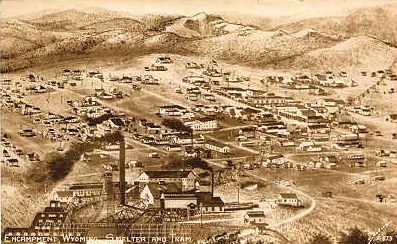
Encampment, Wyo.,C.1903
The above view depicts Encampment shortly after the turn of the century.
Running from the Boston-Wyoming Smelter in the foreground, to the right and up is the world's longest
arial tramway bringing ore from the Rudefeha Mine discussed on the next page.
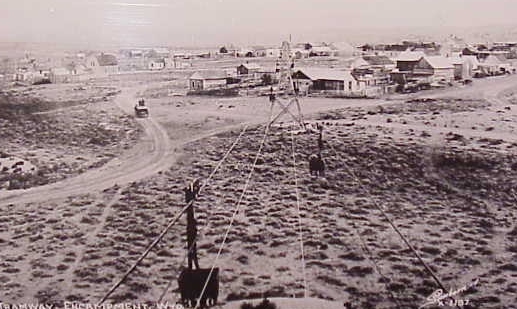
Aerial Tramway, Encampment, prior to 1908
The tramway was completed in 1902 with the first ore delivered in June, 1903.
The tramway utilized 985 buckets traveling at 4 miles per hour to move the ore from
the mine at Battle, Wyo. A fire at the smelter, a drop of 35% in the price of copper, and
the indictment of the Ferris-Haggarty Company, owner of the mine, ended copper production even
though the mine was not played out.
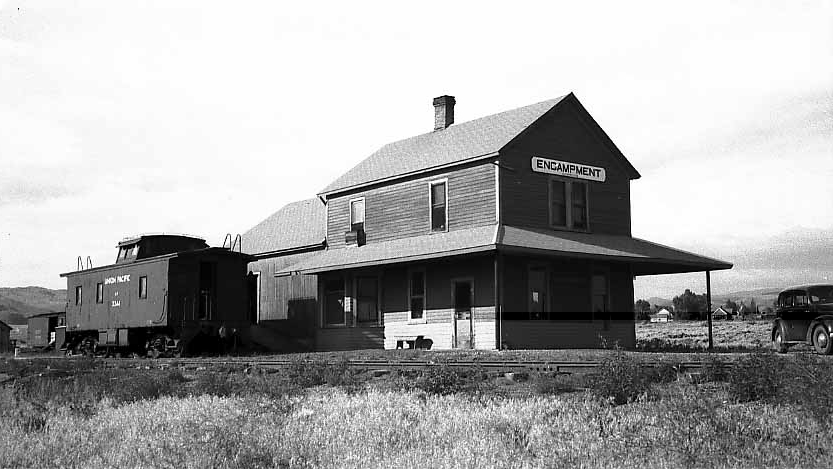
Encampment Depot, approx. 1940
Encampment, founded in the 1870's and now having a population of less than 500 boasted
a much greater population at the height of the copper boom which collapsed just prior to 1908. The Railroad arrived in
1908 just in time for the closing of the mining industry and, thus, had nothing to
haul except lumber until it too closed in 1962.

Engine No. 1242 outside of
Encampment, approx. 1940Engine 1242 built in
in New Jersey in December,
1890, is the oldest locomotive in the state, was used on the Walcott, Saratoga, Encampment Branch Line from 1921 to
1954, and is on display in the Lions Park in Cheyenne.
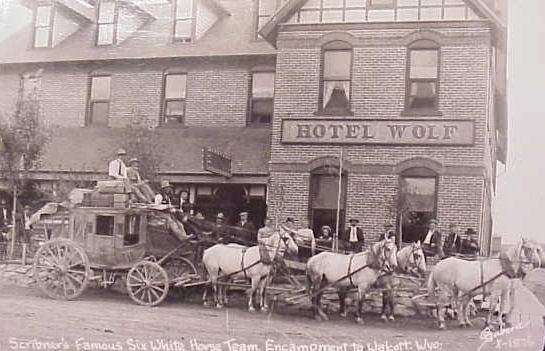
Walcott to Encampment Stage
in front of Wolf Hotel, Saratoga, Wyo.
As noted on the bottom of the photo, the Scribner
Stage Line ran from Walcott, via Saratoga, to Encampment. One of its more colorful
drivers was John Jefferson "G-String Jack" Fulkerson (1860-1947) who arrived in
Saratoga in 1902 from Pueblo where he had driven stages and freighters.
He apparently received his nick name from his skill at driving the 12-horse
teams required to pull the giant freighters which brought the equipment and
other gear into Encampment prior to the coming of the railroad.
For a photo of a 12-horse team pulling triple freighters in Buffalo click here.
Fulkerson also served as
Town Marshal for Saratoga. In the 1930's he and his wife operated the Bohn Hotel
in Encampment, see picture below. The Wolf Hotel, constructed by Frederick Wolf, is still in business in Saratoga.
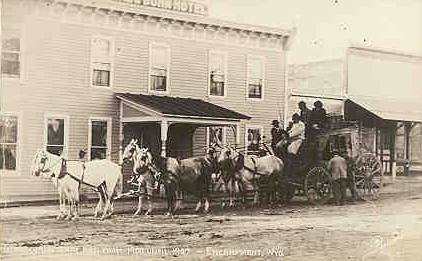
Encampment Stage, 1907
The Walcott, Saratoga and Encampment Stage in front of
the Bohn Hotel in Encampment. As noted above, the hotel was later operated in the 1930's by
one of the drivers for the Scribner Line, John Fulkerson.
As indicated by the above photos, stage lines continued in business serving the smaller
towns of Wyoming until after the turn of the 20th Century. Nine passenger
stages as shown above were not necessarily comfortable. The coach had in its interior three
bench seats, the one toward the front of the coach facing backwards. Seating was on a first come, first seated basis.
The last passenger might be the unfortunate one to have the middle seat facing backwards. The
swaying of the stage on the rutted, potholed roads could easily lead to a severe case of motion
sickness. The bench seats had a width of approximately four feet, meaning that each
passenger had a seat width of only 16 inches, about the same, or slightly greater, as the modern equivalent
of a stage, a commuter airline, and only slightly less than that the 16 1/2 inches allocated in
the steerage section of a modern jetliner. Additionally, prior to the advent of oiled and
hard roads, the passengers were subjected in the summer to great clouds of
dust kicked up by the horses' hooves and by the wheels of the stage. The dust was
so great that passengers were warned against using hair oil which would become caked with the
dirt. Some lines would provide the passengers with "dusters" which would then be laundered
after each trip. During rainy weather canvas or oiled leather flaps would be lowered over the
"windows" to keep out the rain. Luggage and the mail would be strapped to the back and
covered with an oiled leather flap. When there was excess mail the bags would
be placed on the floor of the passenger area and the passengers would have to ride with
their feet on top of the bags and chins resting on their knees. As indicated by the next picture of the Buffalo-Clearmont
stage, in cold weather some lines would encase the coach in canvas in a vain attempt to
keep out the cold.
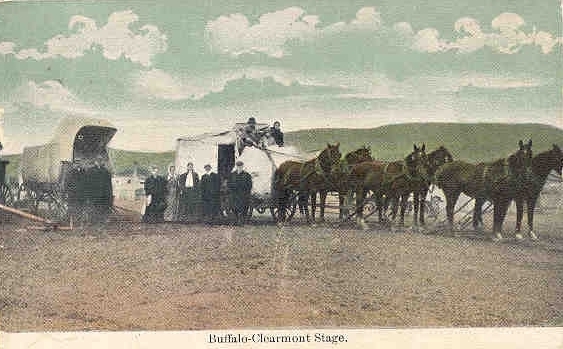
Buffalo-Clearmont Stage, approx. 1910
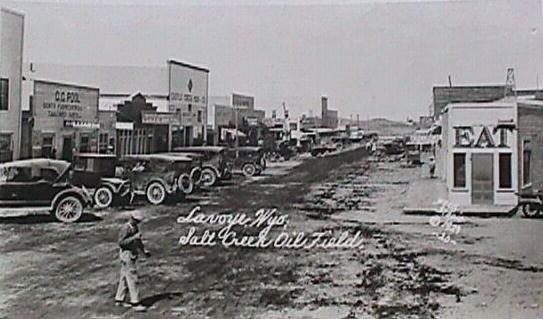
Lavoye, Wyoming in the Salt Creek Oil Field, 1923 |
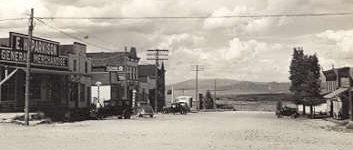
Encampment, 1920's |
While certainly not a part of the mining districts, the same "boom and bust" cycle of the mining industry has also occurred in the
state's petroleum fields. The Salt Creek Oil Field opened in 1922 and shortly thereafter
reached its peak as illustrated by photo of Lavoye and as further exemplified
by the population of Lusk which reached its peak during the Oil Boom but
now finds itself back as a ranching community. The Salt Creek Oil Field was the center of the
Teapot Dome scandal of the 1920's resulting in the first conviction of a
federal cabinet member, Secretary of Interior Albert B. Fall, for bribery and, although
acquitted of the charges of defrauding the United State,
the imprisonment of Henry Sinclair, head of the Mammoth Oil Company, for contempt of the
Senate and attempted jury tampering. Fall received from Sinclair $223,000 in bonds,
$85,000 in cash, 6 heifers, a yearling bull, 2 three-month old boars, 4 sows
and, for his ranch foreman, an English thoroughbred horse.
For more photos of Encampment, 1899-1908, visit
The Lora Webb Nichols Collection, U. of W.
Next page, Rudafeha Mine
|